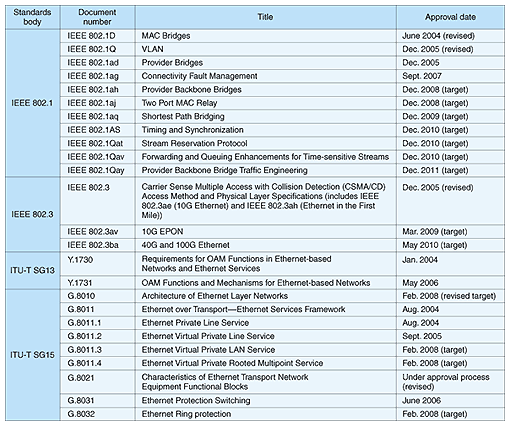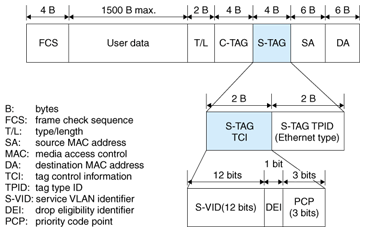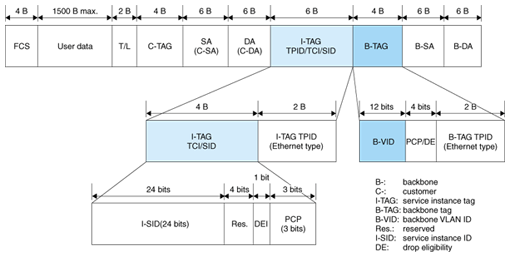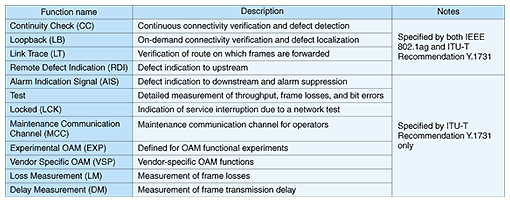 |
|||
|
|
|||
|
Global Standardization Activities Vol. 6, No. 2, pp. 52–56, Feb. 2008. https://doi.org/10.53829/ntr200802gls Standardization Status of Carrier-Class EthernetAbstractThis article introduces the status of recent standardization activities for enhancing Ethernet to make it suitable for telecommunication carrier networks. Ethernet was invented as technology for local area networks. However, since 2002, study and standardization on its enhancement have been progressing rapidly, and as a result, Ethernet can now be used in larger-scale carrier networks and operated efficiently.
1. Standardization and capability enhancement for EthernetUntil around 2002, the standardization of Ethernet was conducted only by IEEE 802 LMSC (LAN/MAN Standards Committee; LAN: local area network, MAN: metropolitan area network). However, in 2002, standardization was also started within ITU-T SG13 and SG15 (ITU-T: International Telecommunication Union Telecommunication Standardization Sector; SG: Study Group) to reflect the requirements of telecommunication carriers. Since then, IEEE 802 LMSC (mainly Working Groups 802.1 and 802.3) and ITU-T SG13 and SG15 have been collaborating closely. They are producing consistent standards by complementing each other. Standardization on the enhancement of Ethernet has been done in the following technical areas:
2. Standardization statusThe standardization status in each technical area is described below. Related IEEE 802 standards and ITU-T Recommendations are listed in Table 1.
2.1 High-bit-rate and long-distance interfacesEthernet interfaces for bit rates of up to 10 Gbit/s and transmission distances of up to 40 km were standardized by IEEE 802.3ae in 2002. With this standard, Ethernet became a viable option for high-speed and long-distance transmission in carrier networks such as SDH (synchronous digital hierarchy) and OTN (optical transport network). In addition, standardization of 40- and 100-Gbit/s interfaces has started in a new project, IEEE 802.3ba, based on the results of HSSG (Higher Speed Study Group) within IEEE 802.3. The objectives indicate that a transmission distance of 100 m will be supported for 40-Gbit/s interfaces and 40 km will be supported for 100-Gbit/s interfaces. In addition, this standard is expected to support OTN, which can be used for long-distance transmission. Thus, ultrahigh-speed and long-distance transmission technologies are expected with this standard. 2.2 Capability enhancement as access networksEFM (Ethernet in the First Mile) was standardized by IEEE 802.3ah in 2004. This standard provides 1-Gbit/s EPON (Ethernet passive optical network) and OAM capabilities for access networks. EPON enables efficient use of optical fibers by sharing an optical fiber among multiple (e.g., 16) customers. The OAM functions allow efficient operation of access networks. In addition, standardization of 10-Gbit/s EPON has been started by IEEE 802.3av to accommodate the increasing traffic demand. 2.3 Enhancement of VLAN scalabilityVLAN was standardized by IEEE 802.1Q. This technology allows logically separate LANs to be defined on a physical Ethernet. Initially, it was assumed that VLANs would be used in enterprise networks. When this technology was applied to carrier networks, both customers and carriers required the capability to define VLANs independently of each other. Provider Bridges were standardized by IEEE 802.1ad in 2005 to meet this requirement. Two sets of VLAN tags are used so that customers and carriers can define a C-VLAN (customer VLAN) and an S-VLAN (service VLAN), respectively. To support even larger-scale networks, Provider Backbone Bridges are under development by IEEE 802.1ah. In addition to the C-tag, this technology uses an I-tag, which includes a 24-bit service identifier, and a B-tag, which defines the backbone VLAN. In IEEE 802.1ad, an S-tag is used for both service identification and VLAN definition. The role of the S-tag was divided into I-Tag and B-Tag for greater scalability in IEEE 802.1ah. It is now under Working Group Ballot, which is the final approval process at the Working Group level. The frame formats of IEEE 802.1ad and IEEE 802.1ah are shown in Figs. 1 and 2, respectively. Both IEEE 802.1ad and 802.1ah use multiple VLAN tags that have the same structure to obtain greater VLAN scalability while maintaining compatibility. This method allows existing switches to be used in the network core while new functions are provided by edge switches.
2.4 Enhancement of OAM functionsEthernet initially did not have OAM functions because it was developed as a technology for LANs. However, demand for OAM functions increased after Ethernet began to be used by carriers. Standardization of Ethernet OAM functions began in 2002 within ITU-T SG13. IEEE 802.1 also started standardization of Ethernet OAM as a new project, IEEE 802.1ag. These standards bodies have been making progress with the standardization in close cooperation with each other. ITU-T Recommendations on Ethernet OAM requirements (Y.1730) and mechanisms (Y.1731) were approved in January 2004 and May 2006, respectively. In addition, a Recommendation on Ethernet equipment (G.8021), which includes OAM functional block specifications, is undergoing approval. IEEE 802.1ag was approved in September 2007. ITU-T Recommendation Y.1731 covers both fault management and performance management functions while IEEE 802.1ag covers only fault management functions. Some fault management functions are covered only by ITU-T Recommendation Y.1731. OAM functions that are covered by both standards use the same specifications, so they are interoperable. The OAM functions covered by these standards are listed in Table 2.
2.5 Fast protection switchingReliability is one of the most important factors when Ethernet is used in carrier networks. The spanning tree protocol and link aggregation have been used as ways to enhance reliability. In addition, ITU-T Recommendation G.8031, which specifies Ethernet linear protection switching, was approved in June 2006. This mechanism uses an alternative transmission line, called a protection transmission line, to protect the working transmission line. If the working transmission line fails, then the system switches to the protection transmission line. This method is widely used for SDH and ATM (asynchronous transfer mode) networks. Furthermore, Ethernet ring protection switching, which allows efficient use of optical fibers, is under development as Draft ITU-T Recommendation G.8032. Consent for the approval of this draft Recommendation is expected to be given at an SG15 plenary meeting in February 2008. These Recommendations allow the use of linear and ring protection switching methods, which have been used widely in carrier networks. 2.6 Enhancement for realtime signal handlingEthernet has mainly been used to transport non-realtime data. Standardization on realtime signal transmission started in early 2006. The main target is the transportation of voice and video signals over Ethernet within a house. Toward this target, the following projects have been created under the Audio Video Bridging Task Group: Timing and Synchronization (IEEE 802.1AS), Stream Reservation Protocol (IEEE 802.1Qat), and Forwarding and Queuing Enhancements for Time-Sensitive Streams (IEEE 802.1Qav). It is expected that a high-quality low-delay transmission method suitable for timing-sensitive signals will be standardized. 2.7 Traffic engineeringEthernet has been developed as a connectionless networking technology. However, a new project, IEEE 802.1Qay, has started to develop PBB-TE (Provider Backbone Bridges Traffic Engineering), which introduces the concept of connection-oriented networking. With this method, operators can establish data paths in accordance with their own policies, which allows traffic engineering. 3. Future workVarious enhancements of Ethernet have been studied and standardized since Ethernet became widely used in carrier networks. NTT will actively contribute to the enhancement of Ethernet to create an environment where Ethernet can be used more widely and efficiently in large-scale carrier networks. |
|||












